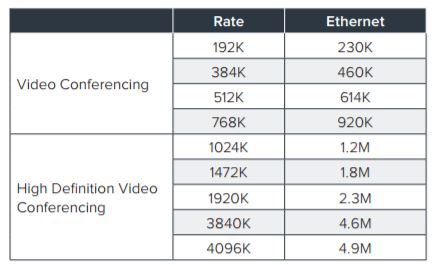Video Conferencing and The Bandwidth Battle

A couple of weeks ago, Vineet Misra, CIO of Lifesize shared an interesting post on the growing need to optimise bandwidth for collaboration technology. This is an area which we have been discussing here at VideoCentric on a much more regular basis recently with many customers of all sizes, often led by the fact that organisations are seeing high demand on their networks and requirements for more and more connected devices and technology; a continual snowball for IT teams who are needing to provide more bandwidth to satisfy not just the number of individual devices connected to the network, but also the quality of service required and the increased bandwidth needed to successfully utilise all the features within each individual application. So we thought we would continue the conversation.
Whilst the adoption of Video Communications and collaboration tools in the workplace continues to grow, employees are also expecting HD quality video as a standard, and most organisations are now heavily invested into IP based communications, whether for critical communications such as phone systems and cloud-based collaboration tools, or for ensuring productivity and efficiency for the ever-growing remote and flexible workforce.
Video Conferencing Bandwidth Demand
Video Conferencing has always been notorious for being a strain on bandwidth consumption. Video traffic requires assured symmetric bandwidth and often priority on networks to reduce packet loss & latency that could distort real-time communications. Plus, Video requires a full duplex network that will enables both transmission and reception of media data.
Years ago when Video was deemed sufficient at SD quality, between 384kbps to 512kbps bandwidth would have been expected for a single Video Conferencing call to be made. Moving forwards into the world of HD Video Conferencing around a decade ago, organisations may have had a single HD Video Conferencing system in their boardroom, and for a point-to-point call, a Full HD Video Conferencing system can require anything between 1 – 2.3Mbps of bandwidth. Scale this up for a multipoint call, and you already start to see how just one Video call can place strain on a low bandwidth network – a 4-way Multipoint conference hosted on an Endpoint at 720p HD could require up to 6Mbps bandwidth.
But todays organisations are no longer looking at single endpoints in one or two rooms either. Add more meeting room Video Conferencing systems, smaller huddle rooms, desktop & UC services, mobile & BYOD conferencing, Collaboration and content tools, IP-based phone systems… bandwidth consumption for every organisation becomes a serious battle that IT must get right to keep the business moving.
Tips for Getting Bandwidth Right
Understand your network requirements and calculate what you need to achieve the quality you require. The table below shows typical transport rates for standard and HD video conferencing, showing the demand on the network over ethernet. Ethernet is approximately the VC rate multiplied by 20% to account for IP Protocol overhead.

You must also plan ahead and estimate future demand on the network. What is the expected traffic? What are your busy hours? Are you looking at cloud solutions for multipoint or looking at keeping a bridge on premise?
Utilise analytics.
This is key to actively manage bandwidth, and recognise when peak times or expansion is needed, before it becomes a problem. There are some great packages for multivendor analytics that can work within your network from the likes of Riverbed, or tools for your specific communications such as the Lifesize Dashboard.
You should also think about prioritising business apps and the most critical applications, so that your directors meeting is not contending with lunchtime browsing across the office. You might be interested in our Cisco & Apple blog for a little more on business app prioritisation alongside wireless networks.
Get Specialist Assistance
There are many options available for ensuring a business network is ready for future communications and the growth of quality and connectivity that your network will see, if not already. Dependent upon budgets and communication requirements, organisations are looking into upgrades for MPLS networks or even ripping out their MPLS and implementing high quality Ethernet Fibre or Ethernet First Mile instead. Don’t assume what you’re told by an advert is suitable. Contention & upstream vs downstream are just two of the many considerations that hugely effect the bitrate you will receive into your network and across your business.
Similarly, organisations may be more suited to Video Conferencing solutions that implement the H.264 High Profile codec, providing HD at a reduced bandwidth, or cloud-services such as the VC365 High Profile service may be a good choice for organisations with a limited bandwidth who still want to utilise a Video Conferencing multipoint service.
Getting broadband right is a key element to today’s enterprise-grade communications. HD video conferencing, seamless communications and high-quality/low-latency calls isn’t achieved just by chance, and to ensure organisations make the most of their technology investments for users to be more efficient and productive, it’s extremely important to get the backbone of the technology right.
Ref: Table 1 from Polycom’s Whitepaper “Preparing your IP Network for HD Video Conferencing”
